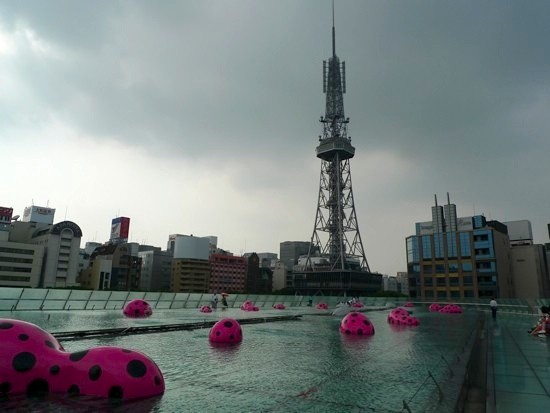
Yayoi Kusama – Inochi no ashiato (2010), installation view at the Aichi Triennale 2010, Nagoya.
On August 21, the inaugural Aichi Triennale officially opened to the public in Nagoya. Taking the theme “Arts and Cities” and directed by Akira Tatehata, director of the National Museum of Art, Osaka, the Triennale is the latest ambitious art event to launch in Japan this year, following the Setouchi International Art Festival in July.
With 70 percent of its funding provided by the Aichi prefectural government, the Triennale features 131 local and international artists and groups spread across centrally located venues including the Nagoya City Art Museum, the Aichi Arts Center, a warehouse space in the Nayabashi district and vacant lots and storefronts in the Chojamachi district. In addition to contemporary artists and filmmakers, participants include those from the fields of dance, theater and opera.
The theme has been broken up into sub-categories including “Celebration,” “The Cutting Edge” and “Complexity.” Highlights of “Celebration” include a large-scale installation by Yayoi Kusama on the rooftop the Oasis 21 commercial building next to the Aichi Arts Center, while site-specific film and neon works by artists including Tatzu Nishi, Nobuhiro Shimura and Cerith Wyn Evans bring a degree of spectacle to the exhibition and transform the urban nightscape of the Chojamachi district.
“The Cutting Edge” features both new works commissioned by the Triennale as well as those incorporating new media technology, as in a collaborative production between director Oriza Hirata and robotics designer Hiroshi Ishiguro, In the Heart of the Forest, featuring robots and humans discussing topics like emotion and ethics together on stage.
“Complexity” provides the framework for much of the Triennale’s inter-disciplinary programming, including performance art, opera and other live programming, with Gallery G at the Aichi Arts Center serving as another venue for performances by artists including Sonia Khurana, who is also displaying photos and video in the exhibition. A number of other participants are similarly contributing both installation and performance pieces.
At an August 20 press conference, artistic director Tatehata said that he hoped that, as a celebration, the Triennale could become a site for new creativity for both participants and visitors alike, and expressed the sentiment that through the Triennale, “It is possible for us all to share the position of being absolute beginners.”
For more, see also ART iT’s Photo Report on the opening of the Aichi Triennale:
Part I. Aichi Arts Center
Part II. Nagoya City Art Museum
Part III. Chojamachi
Part IV. Nayabashi
